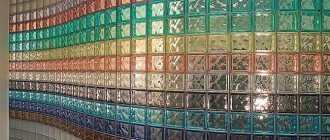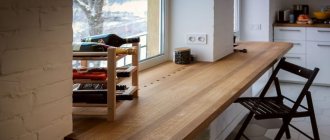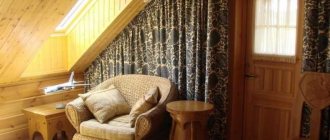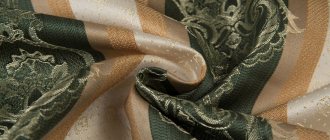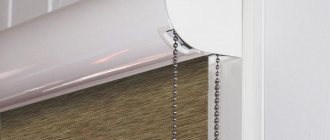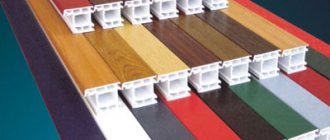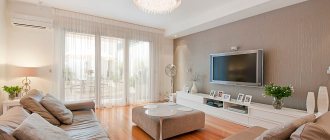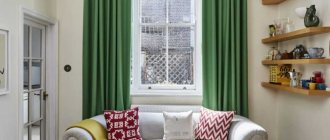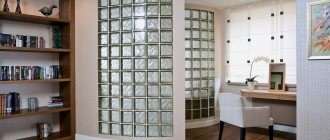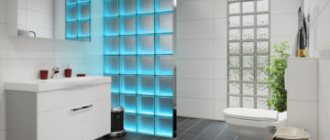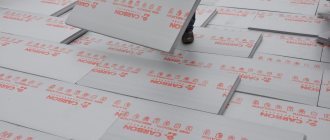The use of glass blocks as decor for practical and aesthetic designs in interior design is becoming increasingly popular today.
Decor in the bedroom interior Source remoo.ru
The material is used for the construction and decoration of walls of residential and industrial premises.
Colored glass blocks in the hallway Source www.rmnt.ru
Blue glass block Source photointeriorpro.ru/
Glass blocks in the bedroom interior Source remontbp.com
What is glass block?
A traditional glass block was a hollow cube with walls made of glass about one centimeter thick, which, due to the internal air cushion, reduced sound transmission by 60–70%, light transmission was 80%, and dense glass blurred the outlines of people behind it and prevented anyone from watching. which was not intended for prying eyes.
In addition, they were very durable, so glass walls made of cubes did not frighten either mothers in kindergartens or residents of Brezhnevkas, whose entrances were regularly decorated with blue-green glass delights.
But as the wise Ovid said: “Tempora mutantur, et nos mutamur in illis” (translation: Times change, and we change with them), so the glass blocks have changed, acquiring new forms - for example, bricks; new content - they are filled with installations, herbariums or mother of pearl; a new type is decoration with ornaments or graphics, as well as painting glass in different colors.
The sizes of glass blocks in apartment interiors vary greatly, but the most popular are standard cubes 24x24x8 and 19x19x8.
What is glass block and how does it work?
Glass blocks are two square glass boxes welded together with sides. Inside there is emptiness, or rather highly rarefied dry air. Dust and condensation cannot fall into the interior of the block, so the glass walls of the block always remain transparent from the inside.
As we know, sound waves, as well as a significant proportion of heat, are transmitted by vibrations of air molecules. Accordingly, the discharged space inside the block does not transmit sound well. The absence of air also prevents the transfer of heat, giving the glass block thermal insulation properties no worse than even double-glazed windows.
True, it would not be entirely correct to say that glass blocks are transparent; their walls transmit about 70% of the light flux. But, now, it will no longer be possible to see anything behind their thick corrugated surface, except for blurred silhouettes.
Glass blocks are suitable where you need to provide good natural light, while at the same time hiding what is happening behind the wall.
Another advantage of glass blocks is their high fire resistance. Thick glass can burst only from a sharp and strong temperature change, but is practically invulnerable to relatively uniform heating even from a strong fire.
Openings filled with glass blocks sometimes resemble exquisite stained glass windows
The aesthetic qualities of modern blocks are noticeably superior to their Soviet predecessors. Today they are produced in a variety of colors and shades, decorated with various designs. Various decorations and unusual objects are placed in the internal voids of the blocks. There are a great variety of design options for both the glass blocks themselves and the design using them.
Types and features of material
So, what kind of finishing material is this and what do glass blocks generally look like in the interior? To put it simply, it is a kind of hollow inside “sandwich” made of two thick centimeter glasses combined with each other. In the Soviet Union they were produced according to standards that have smoothly migrated to the present day.
There are only two size ranges: 19x19x8 and the second - larger - 24x24x8.
The indicators remained the same:
- “filling” of air makes it possible to get rid of external noise in the room by almost 70%;
- they perfectly transmit light, leaving what is happening inside the house closed from prying eyes;
- In terms of strength, this tile can be compared to a brick; it conducts heat better than its counterpart, but one piece weighs significantly more than a brick - up to four kilograms.
What has undergone significant changes today is the appearance of tiles. Only the lazy cannot find a design and shape to suit their taste on the market today: with a pattern and in plain colors, with and without backlighting, in the form of stained glass or installations, decorated with flowers, corals and whatever your heart desires. Choose and conquer.
The form has also undergone significant changes. Today you can find not only classic rectangles and squares, but also triangular and even round options.
Types of glass blocks
Experts qualify them according to the following criteria: size, color palette, texture, shape, glass strength, load resistance and visual characteristics.
Dimensions
Today there are a large number of glass blocks of different heights and widths. Most often you can find sizes from 190x190x80 mm. Do not clutter a small room with too large partitions and massively fill the space with small ones. In the case of finishing, it is necessary to maintain visual harmony of the room and the decorative material.
Color palette
The number of shades is increasing every day. Every color of the rainbow can be found on sale. The most successful shades that fit perfectly into almost any design are white, blue and transparent.
Surface texture
It is this property that affects the rays of light passing through the glass block. There are such popular surface options: smooth, wavy, matte, glossy, transparent, patterned.
Form
Most often on sale you can find such variations in the shape of glass blocks: square, rectangular, triangular, with a rounded edge, round, oval, hexagonal.
Glass strength
It can vary from 5 to 7 mm. The thickness of the material also affects its weight, which is 2-5 kg.
Load resistance
This feature may depend on the desired structure of the glass block inside. This can be an impenetrable partition or a delicate decorative structure.
Visual characteristics
Optical and aesthetic properties include not only color and shape, but also the degree of light transmission, the shape of the glass and the nature of the light flux (can be bright, directional or diffuse).
Advantages and disadvantages of finishing material
pros
Taking into account its characteristics, glass can be harmoniously integrated into almost any room.
- Durability - a wall made of glass blocks will look good in the interior and is guaranteed to serve you for many years.
- Moisture resistance is why glass blocks are very popular in bathrooms.
- Easy to clean. A special glass cleaner, a rag and five minutes of time is all you need.
- Noise insulation. The sound of water, screams on the street or loud music - you can forget about these irritating factors.
- Thermal conductivity. Glass blocks also work well with the air temperature in the room: by maintaining the required level of heat, they make your home even more comfortable.
- Light transmission. The thickness of one layer of glass is more than a centimeter, but this does not prevent almost all sunlight from outside from entering the house - up to 90%.
Minuses
Almost an ideal finishing option, isn't it? But what's the catch? It is usually clarified at the installation stage.
The thing is that to build a structure, you simply need professional skills. And if you don’t have them, be prepared to spend money on a specialist, otherwise you risk failing the entire aesthetic component of the issue.
- Weight. As already mentioned, it is about 4 kilograms per square. This not only complicates the construction process, but also is a significant burden in the overall engineering plan of the premises. To put it simply, if you don’t want to fall into the hands of your neighbors below, you shouldn’t decorate a surface larger than 15 square meters in this way.
- If you are a fan of decorating your walls with paintings or photos, this item is for you. The fact is that you cannot screw screws or drive nails into a glass wall. Hanging a shelf, decorating with a picture or attaching hooks - all this is not about glass blocks.
- The material must not be cut. This means that you will have to fully accept the conditions dictated by the size of the source.
- It is impossible to install wiring in such a wall.
- The design does not allow air to circulate. That is why you should not decorate window openings with them - the apartment will not breathe.
Pros and cons of glass blocks in the interior
- decent sound insulation;
- higher light transmittance;
- strength and reliability of constructed structures;
- complete protection from moisture;
- environmental friendliness, dust protection;
- fire resistance and resistance to extreme temperatures;
- unpretentiousness in sanitation and inertness to aggressive chemical and biological environments;
- protection from prying eyes;
- thermal insulation ability;
- versatility in finishing external premises and external facades;
- improved combinatorics: from shapes, sizes, colors and interior design;
- constructive possibility of arranging niches;
- variability: there are options with an acceptable price “for an average portfolio”;
- a plastic block with significantly less weight can be considered a replacement;
- original, elegant and presentable appearance in the interiors of various rooms.
Along with an impressive list of advantages, one can also identify disadvantages.
- Complexity of installation, requiring certain professional skills.
- The weight of the block is impressive, so experts recommend using an area of no more than 15 square meters for glass blocks. Being lighter, plastic does not withstand significant mechanical loads.
- The glass surface is not suitable for finishing with nails, screws, or dowels.
- Cutting glass blocks is contraindicated. You will have to fully comply with the specified parameters of the source material.
- It is impossible to carry out utilities and electrical wiring inside the blocks.
- Glass material with voids, such as windows, will not allow air to circulate in the room, creating the necessary ventilation in living spaces.
In the living room
Glass blocks in the living room interior can be used to create full-fledged partitions.
The use of glass elements in wall decor looks very interesting, stylish and unusual.
The material is used to construct the base of a small coffee table or a full-fledged dining table.
By decorating the walls with glass blocks, you can highlight the necessary area in the room.
In the bedroom
Glass blocks in the bedroom interior create a calming and relaxing atmosphere due to their ability to diffuse and refract light.
A glass block partition will help create a cozy atmosphere in the sleeping area.
Glass blocks can be used to decorate a doorway or part of a wall.
A wall made of blocks located opposite the window will create a festive atmosphere in the room, especially if you choose colored glass blocks, such as green ones, for decoration.
In the hall
In most cases, hallways have a small area; to visually enlarge the space, you can use light shades in the interior or decorate the corridor with glass blocks.
The door to the living room can be replaced with a beautiful arch made of glass blocks.
The floor and ceiling can also be finished with a strong material, such as blue. You can make a small table from glass blocks near the wall.
Adding glass blocks to your wall trim can help improve illumination in a poorly lit hallway.
In the kitchen
Glass blocks are used more often in creating kitchen interiors. Glass material is used not only for finishing walls, window and door openings, but also for finishing a kitchen apron, decorating and zoning a room.
Recently, glass blocks have been used to make table bases. This decor looks quite interesting and unusual.
Clear glass blocks pair well with white kitchen cabinetry or wood trim.
Original solutions in a modern interior
Glass windows and partitions will no longer surprise anyone. But using this durable yet translucent building material as a base for a floor can bring originality to any interior. Here is just one way to decorate an office with a seating area. The glass roof and glass block floor made the room feel airy, light and airy.
A semi-circular bar counter made of translucent glass blocks? Easy! The design will look especially impressive if you add colored or monochrome lighting to the design.
Small glass block inserts in the walls are a unique opportunity to add originality to the interior of the room. The room is filled with light, reflections play on the surfaces, but the walls do not lose strength and wear resistance.
Creating an internal partition from transparent glass blocks in the staircase space will help create a light, almost weightless image of this structure. The durable design will protect your staircase from direct sunlight from neighboring rooms.
Unusual use of glass blocks is also found in the sleeping area. Windows made from this material can protect your space from prying eyes, but at the same time fill the room with soft sunlight.
Specifications
According to the technological features of the technical processing of glass, glass blocks can be matte, embossed, even and smooth, glossy, colored, colorless, decorated. These indicators influence the light-scattering effect and determine the light-directing component.
Colorless variations have a transparency rate of 70-90%, colored - 50-70%, matte - up to 50%.
The material can have a colorless transparent base or a decorative one. It all depends on the design idea and area of application. And you can choose any color scheme and artistic palette!
Glass LED blocks and illuminated “bricks” are in fashion. Illuminated decorative elements in the voids have a semblance of a 3D effect.
What is a decorative glass block: features of the material
A glass block is a hollow volumetric block created from fused glass plates about 10 mm thick. The product can have a square, triangular, round or rectangular shape. The first option is the most popular. Glass blocks are characterized by dimensions of 190x190 and 240x240 mm, thickness 80-100 mm. The weight of the product depends on the dimensions and averages 3-4 kg.
Glass blocks are moisture resistant, have high sound insulation and heat-saving properties
Glass blocks - the photos clearly show the different options - can be transparent or matte, with a smooth or textured surface, glossy, matte or with a mirror shine, which affects the light-scattering effect. Manufacturers produce products in a variety of colors, ranging from calm neutral shades to bright flashy colors.
Thanks to their special design, glass blocks are characterized by a number of distinctive advantages. Due to the air inner layer, the sound permeability of the material is reduced by 60-70%. The product is at the same time characterized by good light transmittance, and thanks to the dense glass, the outlines of the silhouettes located behind the glass block wall are blurred, this makes it impossible to spy on what is hidden from prying eyes.
Glass blocks are great for zoning a large room
The material is characterized by high strength, resistance to cracking, smooth surface and environmental friendliness, as a result of which it can be used for the construction of partitions in children's institutions. The products have increased moisture resistance, good thermal insulation, resistance to condensation and temperature fluctuations, which makes it advisable to use glass blocks for partitions in bathrooms, saunas and swimming pools.
Glass blocks do not require special care. The surface can withstand an unlimited number of cleanings using any detergent.
The glass block bar counter looks very original and stylish
However, this material is not without drawbacks. Among the main negative aspects is the significant weight of the product, for which reason it is not recommended to build walls made of glass blocks with an area of more than 15 m². In addition, installation of elements is very labor-intensive and requires certain skills and knowledge. Another disadvantage is the high cost of the products. You can buy a glass block from a domestic manufacturer for an average of 150-200 rubles. A product of European quality will cost 300-450 rubles. The cost of a decorative element varies between 1200-1500 rubles. a piece.
How to use glass blocks in home design
Walls and partitions are the most common type of application of the building and finishing material that has become universal. For this purpose, it is extremely durable, soundproof and moisture resistant.
Translucent architectural structures look the most successful and are practical in the interior of a dining room, bathroom, or toilet.
Partitions allow you to zone the studio space, while walls allow you to delimit semantic zones. For example, separate the bathtub from the toilet. Uniqueness and originality are achieved by using blocks of various colors and configurations in the design.
In the kitchen, glass blocks look attractive in the decoration of a bar or island area in the form of stylized partitions.
Shower cabins are often made using semicircular partitions. Glass blocks do not let drops of water through and do an excellent job of increasing illumination: the penetration of natural light and creating an intimate environment, closed from prying eyes. Installations inside blocks of decorative elements “under the aquatic environment”, additional lighting will make the structures “alive” and original.
Glass block windows are most often installed in technical rooms. These include, with a reservation, utilitarian rooms - a bathroom and a toilet. Instead of a “blank wall”, a translucent window made of blocks in a private house is not only a bold, but also a practical, original solution. No additional curtains or blinds are required here.
At the same time, the sizes and configurations of window openings can be of the most intricate shapes, different geometries and locations on the wall.
“Unexpected” solutions in the use of glass blocks in the interior:
- semicircular island counter with lighting, serving as a bar area and serving area for the dining room;
- fragmentary wall inserts made in a “chaotic” but thoughtful design manner;
- the floor and roof of a private house made of durable glass block will make an office, greenhouse, winter garden, attic unique;
- table made of glass blocks on a rigid frame for the strength of the entire structure.
Where are glass blocks used?
Glass blocks are distinguished by good sound-proofing and heat-saving properties, increased resistance to moisture and other external factors.
Application of material:
- For wall decoration or decorative inserts.
- To create partitions by dividing the room into functional zones.
- For finishing external walls of residential premises.
- For zoning the bathroom, finishing the walls of shower corners.
The variety of surfaces, shapes and colors of glass blocks allows this material to be used for interior decoration in different stylistic directions.
Most often, glass blocks are used to decorate the bathroom. The material is practical, resistant to high humidity, easy to maintain, more reliable and durable than drywall. Glass block walls are suitable for decorating a shower stall.
In combined bathrooms, the material can be used to divide a spacious room into functional zones. A straight or round wall made of multi-colored or plain glass blocks can be used to decorate a shower stall or staircase.
You can also create a small partition between the bathroom and the bathroom. In a large room, the washing machine can be separated from the main compartment, creating a small room for washing and storing clothes.
In the bathroom of a country house, you can cover the window with glass blocks with colored patterns or stained glass; when exposed to sunlight, the window looks interesting and unusual. Partitions and walls made of glass blocks are very strong, but they cannot replace load-bearing walls.
Rules for decorating a room with glass blocks
- This material is “contraindicated” to classic styles: classicism, renaissance, baroque, gothic, empire. It is not always appropriate for rural areas: Provence, country, when wood is used in construction and decoration.
- In the design and architectural community, it is generally accepted that the most harmonious ratio of glass blocks to other finishing components of a separate living space is 1 to 10. At the same time, the toilet and bathtub do not have such restrictive recommendations.
- Glass blocks should not be the basis of load-bearing structures. They carry out exclusively decorative and design functions.
- They also successfully cope with zoning of any space, especially studio variations.
- It is advisable to “balance” the use of transparent, colorless materials in the living room with bright notes of color in order to completely avoid the “office” impression.
- Glass combines harmoniously with metal, wood, parquet, laminate, carpets, fabric bases and wallpaper.
Backlit glass blocks for creating walls
Glass inserts in the wall have an additional bonus - the ability to add LED lighting and modernize any vertical plane. Alternative lighting always impresses home guests, especially in an enclosed space under the stairs or as an unusual zoning with alternative lighting.
Glass blocks with geometric patterns look beautiful when light is focused and directed at a specific angle. They look like shining crystals. If you install a mirror wall opposite, it is easy to enhance the lighting in a room without windows.
The most impressive technique in hallway lighting design is to insert movable blocks into the floor, combining them with ordinary porcelain stoneware squares. If you place LED lighting under each glass block, you will get a glowing “moon path” when walking.
Alternative lighting always impresses home guests.
As you can see, this Soviet-era invention has a wide range of applications, and if you apply a design approach, the possibilities will expand. A relatively inexpensive building material with high light transmittance is valued in Latin American countries, Asia and Africa. It is worth taking advantage of foreign experience to bring the most daring design ideas to life.
Limitless design possibilities
Most often you can find glass blocks in the bathroom or kitchen. In the interior of a children's room, bedroom or living room, they are used less often, more as a decoration than a functional element.
The main features of glass blocks that attract designers:
- Decorative glass blocks are capable of transmitting more than 80% of sunlight, while at the same time allowing you to create a barrier behind which you can comfortably retire. This is true for small rooms;
- Glass and plastic blocks are particularly resistant to moisture. These qualities will be useful in residential apartments and houses (bathroom, kitchen, dining room), as well as in public places (dining rooms, saunas, beauty salons, swimming pools);
- The structures are very durable and comfortable to use;
- Glass blocks in the interior of a bathroom or kitchen look organic and fit well with any design and other materials in the apartment;
- A shower cabin made of glass blocks, glass partitions, compositions in door or window openings are very durable, they are convenient and easy to care for;
- Excellent sound insulation (for example, glass blocks will muffle the sound of pouring water by 60-80%);
- Good thermal insulation properties.
Features of interior glass blocks
The material is resistant to moisture, high or low temperatures, and easily transmits light, allowing you to save energy. It is not difficult to maintain glass blocks in their original form: they are easily cleaned of dirt with a damp cloth. Glass blocks in the bathroom interior allow you to increase the space of the room due to the ability of the material to transmit light.
Interior design with glass blocks Source remontbp.com
But there are negative sides to using them. You cannot attach a shelf or any decoration to a glass block wall or partition. They cannot be cut, it is impossible to lay electrical wiring between them.
Wall decoration with glass blocks Source peregorodkainfo.ru
Glass block partitions cannot serve as a load-bearing wall.
Glass blocks in the interior Source roomester.ru
If you cover a window with glass blocks, the ability to ventilate the room will disappear. Double-glazed windows made from glass blocks will help cope with this problem.
Glass block finishing Source dekormyhome.ru
Glass block walls
Today, many owners of small apartments prefer to remove walls and partitions that are not load-bearing, and create interior structures of a more modern and convenient format.
Walls made of glass blocks allow you to perfectly zone the space and effectively complement the modern design of any apartment.
Interior walls made of transparent blocks are an ideal solution for landscaping dark halls, corridors, lobbies, where a lot of sunlight will enter through a glass prism, but the effect of seclusion and separation of one room from another will remain.
The use of glass blocks in large quantities is associated with some aesthetic difficulties.
The design may seem too cold, “soulless”. “Ice cubes” in the interior of the apartment must be supplemented with other materials with a warmer, more comfortable texture.
What types of glass blocks are there?
To build walls from glass blocks or decor, square or rectangular bricks are usually used. The dimensions of the squares have been preserved since the times of the USSR - 19 * 19 * 8 cm or 24 * 24 * 8 cm. Rectangles make up exactly half of the main shape: 19 * 9.5 * 8 cm.
For ease of operation and a more decorative appearance, special end blocks are produced - angular, with rounded edges, cut into a quarter circle. Due to these elements, the erected walls look complete.
In the photo there are amber glass blocks in the living room
30-50 years ago, colored glass blocks were greenish, because... were made from ordinary unrefined glass - it was the most inexpensive. Transparent and crystal clear ones were less common. Modern manufacturers have expanded the line, adding pleasant blue, rich green, neutral brown, as well as yellow, red, purple, pink and other colors.
The color palette increases thanks to the addition of frosted glass to the gloss: so everyone can definitely find something to suit their style and taste
The photo shows glass in a loft style interior
To the usual colored or transparent ones, original inserts are added: glass capsules, inside of which there are compositions of stones, plastic fish or insects, flowers, fruits.
Based on texture, they can be classified as smooth or textured. The second category includes wavy, lattice (Inca), bubble, imitating a waterfall, shagreen.
Partitions made of glass blocks
In modern interior design of apartments and houses, it is customary to form partitions of non-standard shape:
- Pyramid;
- Trapezoid;
- Ziggurat;
- steps;
- Arch;
- Oval;
- Round designs with holes.
A shower cabin made of glass blocks or a partition in the bathroom made of such decorative elements perfectly follows the rhythm of the tiles on the walls and emphasizes the cold aesthetics. Glass is not afraid of moisture, temperature changes, and diffuses light well.
You can “insulate” the sterility of glass partitions using decorative installations inside the blocks.
In a modern bathroom design, you can use shells and other “water” motifs. For the kitchen, gastronomic ornaments and compositions are more relevant. For example, fill the voids of transparent glass blocks with coffee beans or dummies of fruit.
Classification of glass blocks by external surface
Today you can buy not only colorless transparent glass blocks with a smooth surface, but also decoratively designed options. Depending on the area of application and the planned design, you can select blocks of different colors (from neutral, calm shades to bright, flashy colors) and with different surface finishes (smooth, corrugated or patterned). The method of surface treatment affects the light transmittance of the glass and its transparency.
Glass blocks are classified according to the type of surface treatment:
- even, smooth;
- glossy, with a mirror shine;
- matte;
- embossed.
Depending on the type of surface, the blocks can have a light-scattering or light-directing effect.
Formation of window openings
Often, interior windows in apartments and houses are formed using spectacular glass blocks. They give lightness and airiness to the walls and allow better dispersion of the sun's rays.
Particularly noteworthy are the illuminated designs, which look great in the design of living rooms, bedrooms and hallways.
HOW TO LIGHT GLASS BLOCKS WITH YOUR OWN HANDS
Nowadays, glass blocks are becoming more and more in demand. Often this material evokes memories of not so distant Soviet times. Previously, glass blocks were used to build and decorate all kinds of premises. Usually they were used to create walls in public spaces. These are schools, cultural centers, hospitals. It also happened that they became a replacement for walls in houses. Usually such memories are still negative. Glass blocks were not surprising in their variety. They were some kind of cliches, like many other things in the past. Often these were rectangular bricks. The gray color was depressing.
Nowadays everything has completely changed. Glass blocks have become actively used in all kinds of interiors. This material has become diverse today. Attitudes towards glass blocks are radically changing.
You will find more details about glass blocks and their characteristics in the article:
Recommended reading
INSTALLING GLASS BLOCKS WITH YOUR OWN HANDS
But in this article we will consider the possibility of illuminating glass blocks with our own hands.
CONTENTS
- Illumination of glass blocks using LEDs
- Application of glass blocks with backlight
- DIY glass block lighting
LIGHTING GLASS BLOCKS USING LEDS Glass blocks in combination with LEDs are a win-win option for almost any interior. The lighting completely transforms the room at night. Illuminated glass blocks can successfully become a kind of decorative lamp.
The effect is influenced by how many blocks are used, their transparency and the type of glass. A certain backlight tone also plays a role.
Glass blocks with LEDs are usually used in bars, restaurants and other public institutions.
They are used to make bar counters, decorative partitions, illuminated floors and other decorative elements. Illuminated glass blocks in apartments and houses provide additional lighting on the walls and ceiling.
LEDs produce unusual colored light. The small size of the LEDs allows them not to be integrated, but to be placed on the surface of the blocks. Most often, eight sources of unusual light are located at each corner. To do this, a pair of circuits are used that operate independently of each other. If damaged, an accident can be avoided. LED lighting is the economical solution of today. Only 12 V is required to operate.
Glass blocks are not afraid of steam and water. They are perfect for cork floors in swimming pools, kitchens, baths and other rooms. Often a wall is built partially or entirely from these blocks. Glass bricks can visually divide or unite space.
Blocks of clear glass make the objects behind them much clearer. If the material is opaque, then the outlines will only be slightly visible.
The blocks must be installed carefully. This work itself is not difficult at all. The color of the seams is selected individually in each individual case. Manufacturers today offer a huge selection of such popular materials. It is worth deciding on the type of surface and color.
If you combine this material with LEDs correctly, you will be able to create very bright and truly memorable effects. When placed on colorless LED blocks, a truly fabulous sparkle can be achieved.
back to contents
APPLICATION OF GLASS BLOCKS WITH LIGHTING
A wall made of backlit blocks can let in a lot of light. At the same time, the corrugated material will provide protection from unwanted glances. The material itself does not look heavy. As a result, the space is visually completely simplified.
Glass blocks look like fancy cubes that are made from real ice. Designers recommend combining blocks with other materials. In this case, a large wall will look perfect. For example, you can make a third of the wall from glass blocks, and the rest from plasterboard, which is popular in construction.
For high-tech style, transparent blocks are recommended, and for neo-baroque and deco, colored options. Such advice is given by real professionals. A wall of spectacularly illuminated glass blocks will divide the apartment into zones. For example, you can separate the living room from the bedroom. In the kitchen you can separate a work area and a dining area.
You can make a window from LED glass blocks. They will be a great addition to the toilet and bathroom. Such options are also suitable for living rooms, large bathrooms, kitchens and corridors. They are indispensable in pantries and bedrooms.
Blocks are often used to make a screen for a bathtub. It is laid out from them or simply decorated. Place glass blocks under the steps of stairs and podiums.
Illuminated glass blocks will be an effective replacement for many traditional lamps that have already become boring. Based on them, you can make partitions or make unusual filling of window openings. They will also be a great decoration. There are no restrictions on the number of blocks and the place of their use.
This material is reliable, durable and will serve you faithfully for a long time. LEDs are practically the most durable light sources. The most advantageous solution is to combine them with glass bricks. This option would be just the perfect solution. Interior elements that will be made from them will delight you for a long time. In this case, no reconstruction will be required.
LIGHTING GLASS BLOCKS WITH YOUR HANDS
We described a little theory, now a practical lesson, which I found on one good site. In the material presented, the young man decided to renovate a one-room apartment and, as a design idea, planned to use LEDs in the backlighting of glass blocks. I present the material as is, so as not to miss the point:
So, we have turquoise blocks and two yellow ones. The task is for the yellow ones to glow; there is nowhere for them to glow except from the end. The only suitable light source is an LED strip. I went to the LED store and bought a block and strip. More precisely, as I went, a store in the same building where I work, I went next door and bought
